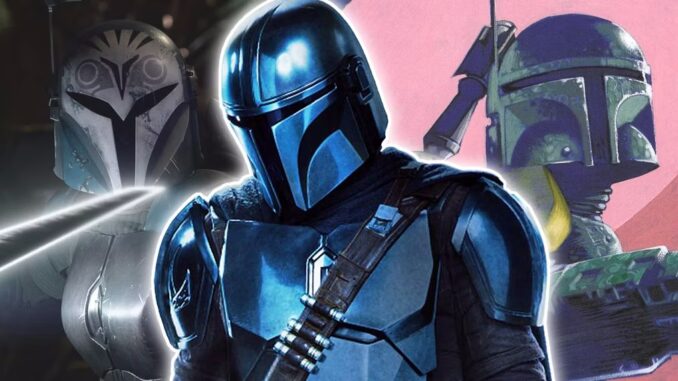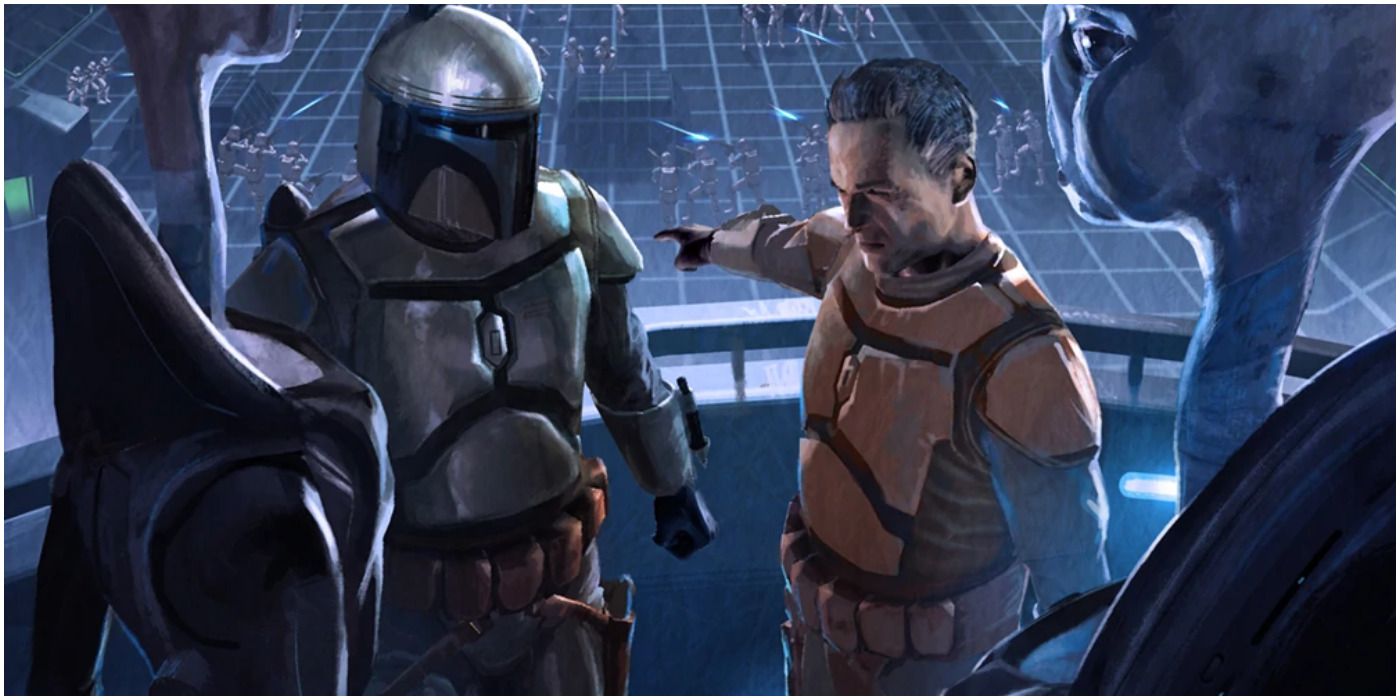
Disney Fixed Star Wars’ Most Convoluted Race by Embracing Expanded Universe Canon
Boba Fett first introduced fans to the Mandalorians while Star Wars Legends explored their ever-changing history, influencing Disney’s current canon.

Star Wars has introduced many memorable races to fans, but few are more storied than the Mandalorians. Boba Fett was the first Mandalorian seen onscreen and everyone was intrigued by the character. For years after, novels, comics, and video games told conflicting stories about Boba Fett and his Mandalorian heritage, introducing both the planet of Mandalore, the mythosaur, and Concord Dawn, where Boba Fett grew up. As the years went by, more lore was added to the race’s history, some of which conflicted with other established lore.
After the Expanded Universe took shape in the ’90s, the lore was cleaned up and eventually heavily expanded upon as the Mandalorians became increasingly important. However, sweeping retcons would also change that lore. The Disney acquisition of Star Wars brought about another retcon, and the Mandalorian history was changed again. The Mandalorian has helped make them very important to the future of Star Wars and has played well with the canon it inherited, creating a new Mandalorian culture borrowed from the past. However, even considering that a lot of lore has been carried over, the Mandalorians of Legends were quite different from the ones canon fans know and love.
Everything We Know About The Mandalorian Season 4
The Millennium Falcon flying in space
The Millennium Falcon’s Original Owner Was No Star Wars Hero
The Millennium Falcon has been owned by some of the biggest heroes in the Star Wars galaxy, but there was a time when the ship lived a simpler life.
Mandalorian history in Legends goes back millennia. It was established at some point that Mandalorians and Jedi were always enemies – with Dark Empire establishing cages and dungeon ships made of “Mandalorian iron” – the beginning of beskar, although it wasn’t named that yet – used to hold Jedi prisoners. The first war between Jedi and Mandalorians that readers got to experience was in 1995’s Tales Of The Jedi: The Sith War, where the Mandalorian raiders led by Mandalore the Indomitable ended up joining forces with Sith Lord Ulic Qel-Droma to battle the Republic and the Jedi Order.
This war occurred four thousand years before the movie timeline. It showed the Mandalorians as a wandering race of warriors, plying the stars with their Basilisk War Droids and attacking planets. They were established as fierce warriors with a nomadic culture, laying the groundwork for Mandalorian lore. Fans also got to play as Canderous Ordo in Star Wars: Knight Of The Old Republic and later Ordo as Mandalore the Ultimate in the sequel The Sith Lords, which took place during the intervening years from The Sith War.
Of course, this came in 1995, years after other bits and pieces of Mandalorian lore were established closer to the time of the movies. Boba Fett was massively popular from the beginning, and fans wanted to know more about the mysterious bounty hunter. Fett appeared in Marvel Star Wars comics but wasn’t the only Mandalorian that would be introduced. The heroes of the Rebellion would end up meeting Fenn Shysa, a Mandalorian leader, and go to the planet Mandalore itself.
This Mandalore was very different than the one in The Mandalorian and Star Wars: The Clone Wars before it and would be the basis for Mandalore in the years to come, a temperate Earth-like planet of varying biomes and far-flung settlements. Star Wars fans got their first glimpse of the mythosaur in Marvel’s Star Wars comics as well, as a massive skeleton was part of the architecture of the capital of Keldabe, which premiered in an issue entitled “Death In The City Of Bone.” Shysa would become a very important character as Mandalorian history developed, becoming the first Mand’alor in years.
Kal Skirata and Jango Fett talking in front of two Kaminoans overlooking training clones
Grogu using the Force with Ahsoka and Luke Skywalker in the background
Grogu Needs a Jedi Master – and There’s Only One Clear Choice
Grogu chose not to train under Luke Skywalker, but he still needs a Jedi Master. With Ahsoka also saying no, there is only one clear choice left.
It was years before there was anything approaching Mandalorian culture in Star Wars. They were a generic human culture, like the Corellians, and much like other human cultures in Star Wars, they excelled at fighting. Boba Fett’s often retconned origin – at certain points, Boba Fett was and wasn’t a Mandalorian by blood – held him being a Journeyman Protector of Concorde Dawn, which was later established as a moon of Mandalore and part of an organization of police officers. The ancient Mandalorians were like the Huns – traveling the stars, conquering and destroying everything before them.
They were an interesting part of the Star Wars Universe – Klingons without the ridges – but all that would change with the Prequels. Yet another Boba Fett retcon changed his past on Concorde Dawn – the EU was famous for retconning on the fly because of how canon worked back then – and the introduction of the Fett-based clone army would eventually lead to the largest expansion of the Mandalorian mythos, including the introduction of Mando’a, the Mandalorian language.
The Clone Wars Multimedia Project – which ran from the summer of 2002 to the summer of 2005 – told the story of the Clone Wars between Attack Of The Clones and Revenge Of The Sith through novels, comics, video games, and Clone Wars, the animated micro-series by Samurai Jack creator Genndy Tartakovsky. One of the video games was Star Wars: Republic Commando, an FPS on the original Xbox that followed the exploits of Delta Squad from the Battle of Geonosis.
A tie-in novel was written by author Karen Traviss – Star Wars: Republic Commando: Hard Contact – which starred Omega Squad as they worked with female Jedi Padawan Etain Tur-Makan. This book introduced several concepts, like Jango Fett bringing in other Mandalorians – known as the Cuy’val Dar – to help train the various commando squads and was successful enough to warrant sequels – Triple Zero, True Colors, Order 66, and Imperial Commando – in which Traviss would expand the lore of Mandalorians significantly. The books introduced Kal Skirata, who adopted all the clones he trained, where the Mandalorian tradition of taking in foundlings began.
Imperial Commando brought the extended Skirata Clan to Mandalore. It began to re-canonize the view of Mandalore from the Marvel comics – a mostly agrarian world garrisoned by the Empire and strip-mined for Mandalorian iron. Mandalorians served as mercenaries to make money for their clans and then came home to farm. Men and women fought on equal grounds, and the Mandalorian tradition of adoption meant that all types of relationships on Mandalore could raise children, which were extremely important to the culture. However, things changed again when George Lucas returned for Star Wars: The Clone Wars.
